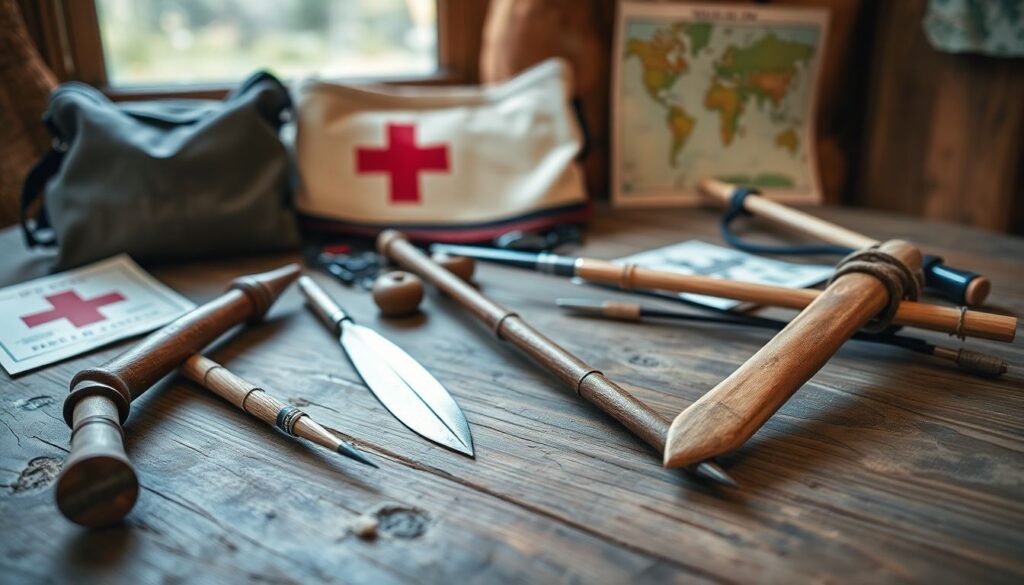Ever wondered what you could fashion into a formidable self-defense tool from your surroundings if you found yourself in a survival situation? The answer might surprise you! In our modern world, we often overlook the potential of everyday items to serve as improvised weapons. But history and statistics tell a different story. Did you know that during World War II, Allied soldiers were trained to turn common household items like chairs, umbrellas, and even shoes into makeshift weapons? Or that in 2017, a man in Florida successfully defended himself against an alligator attack using nothing but a pocket knife and a belt?
So, what makes these ordinary objects extraordinary in the hands of a resourceful individual? The answer lies in understanding their design, physics, and the principles of self-defense. This is where our article, ‘DIY Survival Weapons: Crafting Tools for Self-Defense’, comes in. We promise to demystify the art of creating improvised self-defense tools, guiding you through the process of turning everyday items into effective weapons.
By the end of this article, you will have a comprehensive understanding of how to create your own DIY survival weapons using materials readily available in your home or environment. You’ll learn about the science behind these tools, their advantages, and their limitations. We’ll also discuss the legal and ethical considerations surrounding the use of improvised weapons. Whether you’re a prepper, an outdoor enthusiast, or simply someone interested in self-defense, this article is designed to empower you with knowledge that could one day save your life.
But remember, while these tools can be powerful, they are not a substitute for proper training and awareness. Always prioritize prevention and de-escalation techniques. Now, let’s dive into the fascinating world of DIY survival weapons and explore how you can turn ordinary objects into extraordinary tools for self-defense.
Mastering Homemade Self-Defense Options with Improvised Tools
In the realm of self-defense, the ability to adapt and innovate can often be the difference between a challenging situation and a successful resolution. ‘Mastering Homemade Self-Defense Options with Improvised Tools’ delves into the art of turning everyday objects into effective defensive implements. From the humble pen to the versatile umbrella, this guide explores the potential of common items to serve as deterrents or, if necessary, tools for self-defense. It’s not about turning your home into a fortress or your bag into a weapons cache, but rather about understanding the functionality of objects you already own. By learning to see the potential in the ordinary, you’ll gain a newfound confidence in your ability to protect yourself and your loved ones. This isn’t about encouraging violence, but about empowering individuals to be prepared, to be aware, and to be safe. So, let’s roll up our sleeves, look around, and discover the hidden strengths of the items we use every day.

Understanding the Basics of DIY Survival Weapons
In the realm of survival and self-defense, the ability to create your own weapons can be a crucial skill. DIY survival weapons, crafted from everyday items, can provide a sense of security and empowerment in challenging situations. They can serve multiple purposes, from protection against threats to hunting for food. However, it’s essential to understand their uses, the legal considerations, and the categories they fall into.
The importance of DIY survival weapons lies in their accessibility and versatility. They can be made from materials readily available in your environment, making them a practical option when resources are scarce. Moreover, they can be used for various purposes, such as cutting through obstacles, defending against attacks, or even signaling for help.
DIY survival weapons can be categorized into three main types: improvised blades, impact weapons, and projectile weapons.
- Improvised Blades: These are sharp-edged tools made from items like glass, metal, or bone. They can be used for cutting, stabbing, or slashing. Examples include a makeshift knife from a broken bottle or a spear from a sharpened stick.
- Impact Weapons: These weapons rely on force to incapacitate an opponent. They can be made from heavy objects like rocks, pipes, or even improvised clubs. The goal is to deliver a powerful blow, not to cut or stab.
- Projectile Weapons: These weapons propel an object towards a target. Examples include slingshots made from rubber bands and a spoon, or a simple bow and arrow crafted from a branch and string.
While the idea of creating and carrying DIY weapons might seem appealing, it’s crucial to consider the legal implications. Laws regarding homemade weapons vary greatly depending on your location. Some places may allow them, while others strictly prohibit their possession. It’s your responsibility to understand and adhere to the laws in your area. Always prioritize safety and legality over impulsive decisions.
In conclusion, DIY survival weapons can be a valuable addition to your survival kit, offering versatility and accessibility. However, it’s vital to understand their uses, the legal considerations, and the categories they fall into. Always remember that the best weapon is the one you have with you, and the best tool is the one you know how to use.

Gathering Materials: Foraging for Weapon Components
Embarking on a journey to craft DIY weapons from nature’s bounty is an exciting and rewarding endeavor. The first step in this process is to understand the materials you’ll be working with. Nature provides an abundance of resources, but it’s crucial to know how to identify and safely gather them. Let’s delve into the world of foraging for weapon components.
To begin, familiarize yourself with the local flora and fauna. Some common materials used in DIY weapon crafting include wood, stone, bone, and plant fibers. Wood is an excellent choice for handles and shafts, while stone and bone can be used for blades and tips. Plant fibers can be used to bind components together or create cordage for bowstrings.
When foraging for wood, look for hardwoods like oak, maple, or hickory. These woods are dense and strong, making them ideal for weapons. Avoid softwoods like pine or cedar, as they are too flexible and prone to breaking. To harvest wood, use a sharp knife or saw to cut branches or small trees. Be sure to leave the area as you found it by removing any debris and covering exposed roots.
Stone and bone can be found in various locations, depending on your environment. Beachcombing can yield a variety of stones, while animal remains can provide bone. When gathering stones, look for ones that are dense, smooth, and free of cracks. For bone, ensure that it’s clean and free of any decay. Always respect wildlife and only take what you need.
Now, let’s discuss the advantages and disadvantages of using natural materials versus man-made ones. Natural materials are renewable, sustainable, and often more affordable than their man-made counterparts. They also have a unique aesthetic that can’t be replicated with manufactured materials. However, they can be less durable and more susceptible to the elements. Man-made materials, on the other hand, are typically more durable and longer-lasting, but they can be more expensive and have a greater environmental impact.
In conclusion, foraging for weapon components is a skill that requires knowledge, patience, and respect for nature. By understanding the materials available in your environment and how to safely gather them, you can create functional and unique DIY weapons. So, grab your foraging basket and head out into the wild. Nature’s workshop awaits!

Crafting Improvised Blades: Knives and Swords
Crafting improvised blades, such as knives or swords, can be a fascinating and practical skill to learn, especially for those interested in survival, bushcraft, or historical reenactment. While it’s crucial to remember that these tools should only be used for educational purposes or emergencies, understanding the process can provide valuable insight into human history and ingenuity. This guide will walk you through the steps of creating a simple knife or sword using readily available materials like a sharp rock, a piece of glass, or a metal object. Please note that this process requires extreme caution and should only be attempted by individuals who are responsible and understand the risks involved.
Before we begin, let’s discuss some safety measures. Always wear appropriate protective gear, including gloves, safety glasses, and a long-sleeved shirt. Ensure you’re working in a safe, well-lit area, away from children and pets. Keep a first aid kit nearby, as accidents can happen even with the utmost care. Never point your improvised blade at anyone, and always keep it sheathed or covered when not in use.
Now, let’s dive into the crafting process. The first step is to gather your materials. For a stone knife, you’ll need a sharp rock, such as flint or obsidian. For a glass knife, use a piece of broken glass with a sharp edge. For a metal sword, you’ll need a long, thin piece of metal, like a discarded saw blade or a piece of rebar.
Once you have your material, it’s time to shape your blade. For stone and glass, use another rock or a piece of metal to carefully chip away at the material, creating a sharp edge. Be patient and take your time; rushing can lead to accidents. For metal, you can use a grinder or a file to shape your blade. Remember to wear appropriate safety gear when working with power tools.
Next, you’ll need to create a handle. For stone and glass, you can use a piece of wood, leather, or even a length of cloth. For metal, you can create a handle from a piece of wood or wrap it in leather. Make sure your handle is secure and comfortable to hold.
Once your blade is shaped and your handle is attached, it’s time to test your creation. Be gentle at first, as improvised blades can be fragile. With proper care and maintenance, your blade should serve you well.
Speaking of maintenance, it’s essential to keep your blade clean and dry. After each use, wipe it down with a clean cloth and store it in a dry place. For metal blades, you can use a bit of oil to prevent rust. Never leave your blade in a damp or humid environment.
In conclusion, crafting improvised blades can be a rewarding experience, allowing you to connect with our ancestors and understand the tools they used to survive. However, it’s crucial to remember that this is a serious task that requires responsibility and caution. Always prioritize safety and use your newfound skills wisely.

Impact Weapons: Clubs, Maces, and Hammers
In the realm of self-defense and survival, impact weapons, also known as improvised weapons, can be crafted from everyday objects or natural materials found in your surroundings. These weapons leverage the principles of leverage and force multiplication to enhance your striking power. Let’s delve into the world of impact weapons, focusing on clubs, maces, and hammers, and explore how to create and choose the right one for a given situation.
Clubs, the most basic and versatile of impact weapons, can be fashioned from a sturdy branch, a broom handle, or even a length of pipe. To create a club, select a straight, strong piece of material, ensuring it’s longer than your forearm for optimal reach and balance. The grip can be wrapped with cloth or tape for better handling. Clubs are excellent for striking and blocking, making them ideal for close to medium-range combat.
Maces and hammers, on the other hand, are designed for crushing and smashing. A mace can be created by attaching a heavy object, like a rock or a metal weight, to a long handle using rope, wire, or even duct tape. Hammers can be fashioned similarly, but with a more defined striking surface. Both are devastating at close range, capable of incapacitating an opponent with a single blow. However, they lack the versatility of clubs for blocking and require more space to swing effectively.
When choosing an impact weapon, consider the situation, your surroundings, and your physical capabilities. Clubs are generally the best all-around choice, offering a good balance between reach, versatility, and ease of creation. Maces and hammers are better suited for close-quarters combat or when you need to breach or destroy obstacles. Always remember, the most important aspect of any weapon is your ability to wield it effectively and safely.
Here’s a simple guide to help you choose the right impact weapon:
- For close to medium-range combat and versatility, opt for a club.
- For close-quarters combat and breaching obstacles, choose a mace or hammer.
- Consider your surroundings; urban environments may offer more options for improvised weapons like pipes or metal objects, while wilderness settings might require you to craft weapons from natural materials.
In conclusion, impact weapons can be powerful tools for self-defense and survival, but they should always be used responsibly and as a last resort. Practice proper safety measures when handling and creating these weapons, and always respect the power they wield.

Projectile Weapons: Slingshots, Bows, and Spear Throwers
In the realm of primitive or survivalist projectile weapons, three timeless tools stand out: the slingshot, the bow, and the spear thrower. Each offers unique advantages and challenges, and all can be crafted using natural materials and found objects. Let’s delve into the art of creating and using these simple yet effective weapons.
Slingshot:
The slingshot is a versatile and easy-to-make weapon, perfect for small game hunting or target practice. To create one, you’ll need a forked stick, a piece of rubber tubing, and some string or paracord. First, insert the rubber tubing into the fork of the stick, stretching it taut. Next, tie the string to the ends of the rubber tubing, creating a pouch for your projectile. The slingshot’s advantage lies in its portability and ease of use, but it requires practice to master accurate shooting.
Bow:
The bow is a classic projectile weapon, offering greater range and power than the slingshot. To craft a simple bow, find a flexible, strong wood like yew or elm, and shape it into a D-shape. Attach a string made of sinew, rawhide, or strong plant fibers to both ends. The bow’s main disadvantage is its size, making it less portable than other weapons. However, it’s highly effective for hunting and defense.
Spear Thrower:
The spear thrower, or atlatl, is an ancient tool that increases the range and power of thrown spears. To make one, find a sturdy, straight stick and carve a notch at one end to hold the spear. The atlatl’s advantage is its ability to propel a spear farther and faster than an arm alone. However, it requires practice to use effectively and safely.
Safety and Effective Use:
When using these weapons, always prioritize safety. Never point them at anything you don’t intend to hit, and keep your distance from others. Practice makes perfect, so spend time honing your skills before relying on these weapons in a survival situation. Additionally, respect local laws and regulations regarding the use of projectile weapons.
In conclusion, the slingshot, bow, and spear thrower offer unique advantages and challenges. Crafting and using these weapons can be a rewarding experience, connecting us with our ancestors and the natural world. So, grab some materials and give it a try – just remember to do so safely and responsibly.

Improvised Tools for Self-Defense: Multi-purpose Items
In the realm of self-defense and survival, versatility is not just an advantage, it’s a lifeline. Multi-purpose tools, crafted from everyday items, can transform ordinary situations into extraordinary solutions. Let’s explore how to create and utilize such tools, ensuring we’re always prepared, whether we’re facing a mundane task or a challenging survival scenario.
The key to creating multi-purpose tools lies in understanding the potential of common objects. A simple pen, for instance, can be more than just a writing instrument. Its sturdy plastic body can be used to poke, prod, or even strike, while its ink cartridge can create a makeshift ink bomb for deterring an attacker. Similarly, a belt can serve as a makeshift tourniquet in a medical emergency, a weapon in a self-defense situation, or a means to secure items together.
To create your own multi-purpose tools, start by looking at the items you carry daily. A pocket knife, for example, can be used to cut, slice, and even defend. But with a little creativity, it can also be used to start a fire (by creating a spark with its blade against a hard surface), or to repair gear (by cutting and splicing materials).
Remember, the goal is not to create a single tool that does everything, but to combine and adapt items you already have to suit various needs. This is where the concept of ‘improvised tools’ truly shines. A simple bandana, for instance, can be used as a makeshift sling, a tourniquet, a filter for water, or even a weapon when filled with sand and swung.
In a survival situation, versatility and adaptability are crucial. They allow you to think outside the box, to use what you have in new ways, and to overcome challenges that might otherwise seem insurmountable. So, the next time you’re packing your bag, look at each item not just for what it is, but for what it could be. You might just find that your ordinary belongings hold extraordinary potential.

Maintenance and Care of DIY Survival Weapons
Maintaining and caring for your DIY survival weapons is not just about keeping them in good working order, but also about ensuring your safety and the safety of those around you. Regular upkeep is crucial to prevent accidents and to ensure that your weapons are ready to use when you need them most. Let’s dive into the key aspects of maintaining your homemade weapons.
The first line of defense in weapon maintenance is regular cleaning. Depending on the type of weapon, this could involve disassembling it, removing any dirt, debris, or rust, and then reassembling it. For example, if you’ve made a bow from scratch, you’ll want to wipe down the string after each use to remove any moisture and prevent it from fraying. If you’ve crafted a spear, ensure you clean the shaft and the blade, drying it thoroughly to prevent rust.
Sharpening is another vital aspect of weapon maintenance. A sharp weapon is not only more effective but also safer to use. The frequency of sharpening depends on how often you use your weapon. If you’re using it regularly, you might need to sharpen it every few weeks. For weapons like knives or axes, use a sharpening stone or a honing rod to maintain a keen edge. For bladed weapons like spears or arrows, ensure the blades are sharp and the edges are free of nicks.
Proper storage is the final piece of the puzzle. Storing your weapons correctly can extend their lifespan and prevent damage. For example, bows should be stored unstrung to prevent the string from stretching out of shape. Knives and axes should be stored in a dry place, away from direct sunlight, to prevent rust. If you’ve made a slingshot, store it in a cool, dry place, and consider wrapping the rubber bands in plastic to prevent them from drying out.
In conclusion, maintaining your DIY survival weapons is a continuous process that requires regular cleaning, sharpening, and proper storage. By following these steps, you can ensure that your weapons remain functional, safe, and ready for use when you need them most.

Legal Considerations and Ethical Guidelines for DIY Survival Weapons
Crafting and carrying DIY survival weapons, while intriguing, comes with a web of legal and ethical considerations that demand careful navigation. Let’s untangle this web together, ensuring we stay on the right side of the law and maintain our ethical compass.
Legal Considerations:
The legality of DIY weapons varies greatly depending on your location. In many jurisdictions, it’s illegal to carry or possess certain homemade weapons, or they may require specific licenses or permits. For instance, in the United States, the Gun Control Act of 1968 prohibits the possession of firearms not registered to the manufacturer. Additionally, some states have restrictions on weapons like switchblades, brass knuckles, or slingshots. Therefore, it’s crucial to familiarize yourself with your local, state, and federal laws.
Ethical Guidelines:
Even where legal, using DIY weapons raises ethical questions. The primary guideline is the principle of proportionality. You should only use a weapon in self-defense or to protect others when the threat is imminent and the force used is proportional to the threat. For example, using a homemade weapon against a verbal threat would likely be disproportionate and unethical. Additionally, consider the principle of least harm. If you can achieve your goal (like scaring off an intruder) without using a weapon, that’s always the preferable option.
Responsible and Ethical Use:
- Here are some steps to guide you in using your DIY weapons responsibly and ethically:
Know the Law:
- Understand and follow all applicable laws. If you’re unsure, consult with a legal professional.
Train and Practice:
- Ensure you’re proficient in using your DIY weapon. Practice makes perfect, and proficiency can mean the difference between life and death.
Store Safely:
- Keep your weapons secure, out of reach of children and unauthorized individuals.
Use as a Last Resort:
- Only use your DIY weapon when all other options have failed and you’re facing an imminent threat.
Report Usage:
If you’ve used your DIY weapon, especially in self-defense, report it to the appropriate authorities.
In conclusion, while DIY survival weapons can be fascinating and empowering, they also come with significant responsibilities. Always stay informed, act ethically, and respect the law. After all, with great power comes great responsibility.

Practice and Training: Mastering the Art of Self-Defense
Mastering the art of self-defense is a journey that requires dedication, practice, and a keen understanding of your surroundings. While traditional martial arts and combat sports are excellent ways to learn self-defense, incorporating DIY weapons into your training can significantly enhance your skills and preparedness. Homemade weapons, when used responsibly and ethically, can provide an additional layer of security and empower you to defend yourself in various situations.
Practicing with DIY weapons is crucial for several reasons. Firstly, it allows you to familiarize yourself with unconventional tools, which can be invaluable in real-life situations where you might not have access to traditional weapons. Secondly, it encourages creativity and adaptability, as you learn to improvise and make the most of your environment. Lastly, it promotes a deeper understanding of self-defense principles, as you must apply these concepts to different tools and scenarios.
To develop effective self-defense techniques and strategies using homemade weapons, follow these tips:
- Understand the weapon: Research and learn about the DIY weapon you’re using. Understand its strengths, weaknesses, and how to handle it safely.
- Practice regularly: Consistency is key in mastering any skill. Regular practice will help you build muscle memory and react instinctively in threatening situations.
- Train in various scenarios: Self-defense is not one-size-fits-all. Train in different environments and situations to prepare for a wide range of threats.
- Learn from experts: Seek guidance from experienced martial artists, self-defense instructors, or online resources. They can provide valuable insights and techniques tailored to DIY weapons.
- Safety first: Always prioritize safety when handling and practicing with homemade weapons. This includes using protective gear and ensuring your training space is secure.
Remember, the goal of self-defense is not to fight, but to avoid, de-escalate, or escape dangerous situations. DIY weapons should be used as a last resort and only when your life is in immediate danger. Always respect local laws and regulations regarding the use and possession of weapons.
In conclusion, practicing and training with DIY weapons can greatly enhance your self-defense skills. It encourages adaptability, creativity, and a deeper understanding of self-defense principles. So, grab your homemade weapon of choice and start your journey towards mastering the art of self-defense today!
FAQ
What are DIY survival weapons and why are they important?
What are some common materials used to make DIY survival weapons?
How can I make a simple wooden club for self-defense?
- Find a straight, sturdy branch or piece of wood, about 1.5 to 2 feet long and 2 to 3 inches in diameter.
- Using your knife or saw, cut the wood into a club shape. One end should be rounded for striking, while the other end should be flattened for a better grip.
- Wrap the handle with rope or cord, securing it tightly to prevent slippage. You can also wrap it in a spiral pattern for added grip.
- Test your club by swinging it gently to ensure it’s balanced and comfortable to use.
What is a improvised spear and how can I make one?
- Find a sturdy, straight branch or pole, about 5 to 6 feet long and 1 to 2 inches in diameter.
- Using a sharp knife, carve one end of the wood into a sharp point. You can also harden the tip by heating it over a fire and then quenching it in water.
- If desired, wrap the other end with rope or cloth for a better grip.
- Test your spear by thrusting it gently to ensure it’s balanced and comfortable to use.
How can I make a makeshift knife from a piece of metal?
- Straighten the can tab as much as possible.
- Using pliers, bend one end of the tab into a sharp point. Be careful not to cut yourself.
- Wrap the other end of the tab around a small stick or piece of wood to create a handle. Secure it tightly with tape or cord.
- Test your makeshift knife by gently cutting into a piece of wood or other soft material.
What are some improvised tools that can be used for self-defense?
- Pepper spray made from hot peppers and vinegar.
- A slingshot made from a forked stick, rubber bands, and a pouch.
- A garrote made from a length of wire or cord.
- A smoke bomb made from sugar, baking soda, and a fuel source like alcohol.
- A signaling device made from a mirror or a shiny object to attract attention.
How can I make my DIY survival weapons more effective?
- Practice using your weapons regularly to improve your skills and familiarity with them.
- Hardening the tips of your weapons by heating and quenching them can make them stronger and more durable.
- Adding weights to the striking end of a club or the tip of a spear can increase their impact and range.
- Experiment with different materials and designs to find what works best for you.
- Always remember that the most important aspect of self-defense is your ability to use your weapon effectively and safely.
Are there any legal considerations when it comes to DIY survival weapons?
- In many places, it’s illegal to carry a weapon that could be considered a ‘dangerous or deadly weapon’ without a permit or license.
- Some improvised weapons, like switchblades or brass knuckles, are specifically banned in certain jurisdictions.
- It’s illegal to use a weapon in a threatening or assaultive manner, regardless of whether it’s homemade or store-bought.
- Always check your local, state, and federal laws to ensure you’re in compliance with the law.









